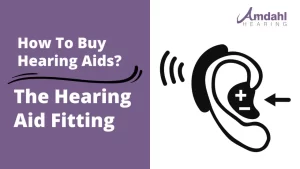Congratulations! You’ve made it this far. You’ve had the courage to get your hearing tested, accepted the results, and decided to pursue amplification. Now the real work begins!
Your hearing aid fitting should be broken up into four parts. Those parts are;
- Physical fit of the hearing aids
- Acoustic fit of the hearing aids
- Hearing aid programming
- Basic care and feeding of your new hearing aids
Physical Fit
The physical fit and comfort of your new hearing aids is paramount to your success. Your provider should ensure that the hearing aids are comfortable, yet snug. The ultimate goal of physical fit is for you to not even be aware that you are wearing hearing aids, but don’t expect that right away. For most people, it’s not normal to walk around with something in their ears, so it’s reasonable that you will be aware of something in there for at least a few days. If your new hearing aids are at all uncomfortable, meaning there is excessive pressure or even a little pain in your ears, make sure you speak up right away. It is much easier to feel the issue then it is for your provider to see the issue. Also, awareness of physical fit does not stop when you leave the office. Small pressure points may develop over the course of hours or even days. I always recommend that patients call right away if they experience any discomfort.
Acoustic fit
I know what you’re thinking. “What in the world is acoustic fit?” In my experience, acoustic fit is as important, if not more important, than physical fit. I define acoustic fit as the degree to which putting something in your ear changes the way you hear internally and externally. In normal English, that means when you put something in your ear it will likely change the way you hear everything around you, as well as make your own voice sound funny. While some of this is normal, providers have to be very careful that this change is not significant, as it may well limit the amount of time a new user will wear their devices.
Hearing Aid Programming
Hearing aid programming is really where the rubber meets the road. Programming is how the hearing aid is set relative to the acoustic parameters of your ear canal, and your specific hearing loss. Hearing aid programming is not simply a matter of looking at the hearing loss and adding a certain amount of power. The amount of power must be measured at the level of the eardrum to ensure the appropriate amount of power is being delivered at exactly the right pitch. It’s important to note here that it’s very likely that your provider will not fit you at full prescription strength at the initial fitting, as often times a patient needs a little bit of time to get used to a full prescription.
Basic Care and Feeding
The term “basic care and feeding” always makes me smile a little bit as one of my old professors used to describe hearing aid orientation as such. Once you are provider has established that the physical fit is perfect, the acoustic fit Is appropriate, and the programming is where it needs to be comment it’s time to get to know your hearing aids. A good orientation will include the basic anatomy of the hearing aids oh, how to tell which one is the right hearing aid and which is the left, and how to handle the power supply of the hearing aids. The power supply and maybe a battery, and it may be dealing with getting rechargeable hearing aids on to the charger appropriately. next oh, your provider should help you learn how to appropriately insert and remove your devices. Finally, it’s important that you learn basic cleaning techniques oh, so that if one of your hearing aids were to plug up with wax in the first week or two, you would know exactly what to do.
While there are many more features and adjustments to go over oh, it’s important that we try not to cover too much at the initial fitting. If your provider is covering these main items oh, I suspect that your experience will be positive.
if you have any other questions regarding what goes into a good hearing aid fitting please contact me at 320.252.0094, look up up online at amdahlhearing.com or email me directly at info@amdahlhearing.com.
